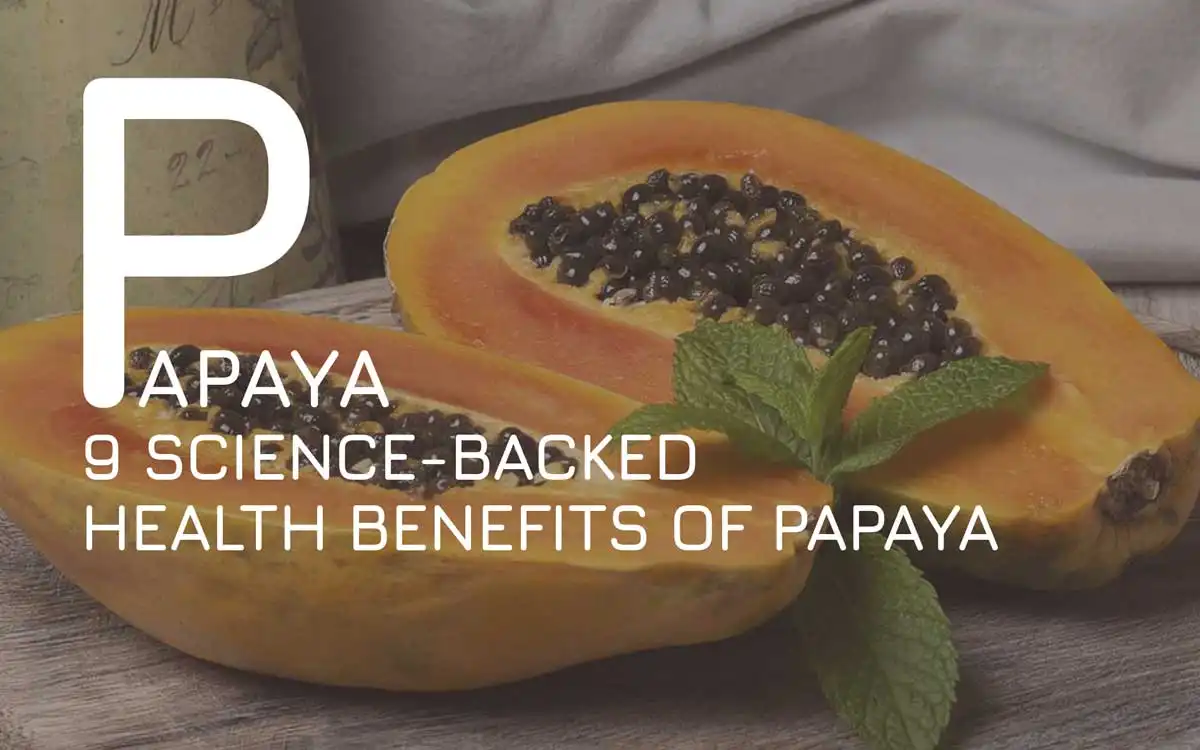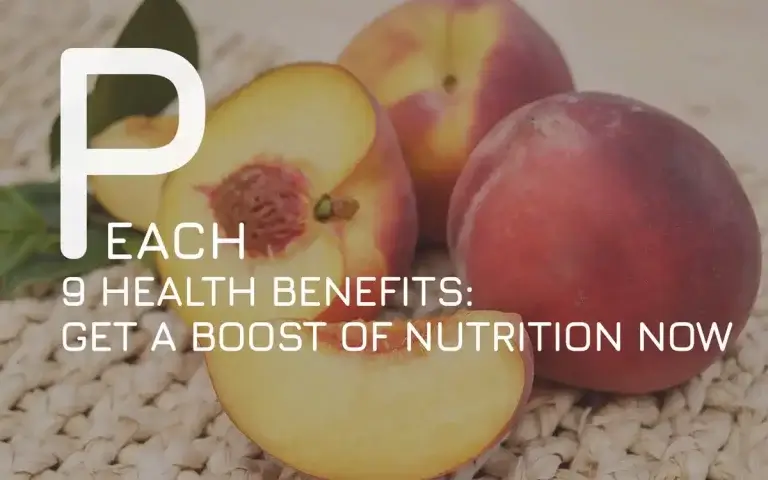9 Science-Backed Health Benefits of Papaya
The benefits of papaya are many! It is a delicious and nutrient-rich fruit, an excellent source of vitamins and minerals, including vitamin C, beta-carotene, potassium, and magnesium. Additionally, papaya contains powerful antioxidants that can help to protect the body against disease. Studies have shown that eating papaya can also help to reduce inflammation, improve digestion, and boost immune function. So, not only is papaya delicious, but it’s also good for you! If you’re looking for a nutritious and delicious way to improve your health, add papaya to your diet today.
What is Papaya?
Papaya is a tropical fruit that is native to Central America. It is often called a “tree melon” because it grows on trees and has a melon-like appearance. Papayas are pear-shaped and can be either yellow, green, or orange in color. They have a sweet taste and are often eaten fresh or used in salads. The seeds of the papaya are also edible and have a peppery flavor.

The skin of the papaya is thin and can be eaten, though some people prefer to remove it before eating the fruit. Papaya is an excellent source of vitamins and minerals, including Vitamin C, Vitamin A, Potassium, and Fiber. It can also help to boost digestion and promote regularity.
In addition to being eaten as a fruit, papaya is also used in traditional medicine. The leaves of the papaya plant are believed to have healing properties, and the fruit is sometimes used as an ingredient in topical treatments for skin conditions. Papayas are a nutritious fruit that can be enjoyed in many different ways.
Papaya Types
There are many different types of papayas, but the three most common varieties are the Solo, Hawaiian, and Mexican papayas.
- The Solo papaya is the smallest of the three, with a bright yellow or orange flesh. It is very sweet and has a soft texture.
- The Hawaiian papaya is the largest of the three, and has a greenish-yellow flesh. It is not as sweet as the Solo papaya, but has a pleasing flavor.
- The Mexican papaya is somewhere in between the Solo and Hawaiian in terms of size and sweetness. It has a pink or orange flesh, and is considered to be the tastiest of the three varieties.
Papayas are an excellent source of vitamins A and C, and are also a good source of fiber. They can be eaten fresh, or used in salads, smoothies, or sauces.
Papaya nutrition facts
Papayas are a nutritious and delicious fruit that can be enjoyed in a variety of ways. They are an excellent source of vitamins A, C, E and B9-folate; they contain fiber and antioxidants; and they are low in calories. Additionally, papayas have been shown to promote digestion, lower blood pressure, and boost immunity. Because of their nutritional profile, papayas make a great snack or addition to any meal.
100 grams of raw papaya contains the following nutrients:
- 88 grams water
- 43 calories
- 11 grams carbohydrates
- 0.26 grams fat
- 0.47 grams protein
- 1.7 grams fiber
- 61 milligrams Vitamin C (81% of RDI)
- 37 micrograms Vitamin B9 – folate (9% of RDI)
- 47 micrograms Vitamin Α (7% of RDI)
- 182 milligrams potassium (7% of RDI)
- 21 milligrams magnesium (7% of RDI)
- 0.045 milligrams copper (5% of RDI)
- 2.6 micrograms Vitamin K (3% of RDI)
- 0.04 milligrams Vitamin B6 (3% of RDI)
- 0.36 milligrams Vitamin B3 – niacin (3% of RDI)
- 0.25 milligrams iron (3% of RDI for men and 1% of RDI for women)
- 0.03 milligrams Vitamin B2 – riboflavin (3% of RDI)
- 0.3 milligrams vitamin E (2% of RDI)
- 0.023 milligram Vitamin B1 – thiamin (2% of RDI)
- 20 milligrams calcium (2% of RDI)
- 0.1 milligrams zinc (1% of RDI)
- 10 milligrams phosphorus (1% of RDI)
- 0.6 micrograms Selenium (1% of RDI)
- 274 micrograms Carotene, beta
Health benefits of Papaya
Papaya is a delicious tropical fruit that offers a myriad of health benefits. For starters, papaya promotes proper digestion by helping to break down proteins. Additionally, the enzymes in papaya can help to relieve inflammation, making it a great natural remedy for conditions like arthritis and Crohn’s disease. Papaya is also rich in antioxidants and vitamins A, C, and E, which support the health of the blood and enhance heart health.
Some studies have even shown that papaya may have anti-cancer properties. In addition to all of these wonderful benefits, papaya can also help prevent macular degeneration, asthma, and viral infections. Furthermore, the potent antioxidants in papaya help to slow the signs of aging by fighting free radical damage.
1. Aids digestion
The papaya is a tropical fruit that is rich in nutrients and enzymes. One of the benefits of papaya is that it can help to promote proper digestion. The papaya contains an enzyme called papain, which helps to break down proteins. This can be especially helpful for people who have trouble digesting proteins and have low stomach acid. Papain also helps to break apart amino acids, which makes it easier for the body to use them. In addition, papaya is a good source of fiber, which can help to prevent constipation and have a healthy digestive tract.
2. Increases the production of red blood cells
This delicious fruit is full of vitamins and minerals that are essential for maintaining a healthy blood flow and keep the arteries healthy. For example, papaya contains high levels of vitamin C, which is necessary for the production of new red blood cells. It also contains beta-carotene, an important antioxidant that helps to protect cells from damage, and is a good source of iron, which is necessary for the transport of oxygen in the blood.
One study found that papaya leaf extract was able to increase the platelet and red blood cell counts in mice. This suggests that papaya may be beneficial for people with thrombocytopenia, or low blood platelets. Low blood platelets can lead to a number of problems, including easy bruising and bleeding. In severe cases, it can be life-threatening. This suggests that papaya may help to strengthen the blood, and further research is warranted. However, it is important to talk to a doctor before increasing papaya intake.
3. It aids in the reduction of inflammation.
Inflammation is a response by the body to protect tissue from further damage. It is part of the healing process. However, when inflammation becomes chronic, it can damage healthy tissue and lead to a host of health problems, including arthritis, asthma, and heart disease.
Studies have shown that papaya can help to reduce inflammation. One study found that papaya extract was effective in reducing inflammation in people with rheumatoid arthritis.
Another study found that papaya was effective in reducing inflammation in people with asthma or arthritis. Additionally, papaya has been shown to help reduce the signs of aging by reducing inflammation. These findings suggest that papaya may be an effective natural remedy for inflammation.
4. Improves heart health.
Papaya is a fruit that is rich in vitamin C, which helps protect the body against free radical damage and cholesterol oxidation. Some research has found that a deficiency in vitamin C may be linked to a greater risk of death from heart disease.
Folate is another important nutrient found in papaya, and it helps to convert homocysteine into other harmless amino acids. High levels of homocysteine have been linked to an increased risk of heart disease, so getting enough folate can help to keep your heart healthy.
Papaya also contains antioxidants like carotenoids and flavonoids, which have been shown to help reduce the risk of heart disease. So if you’re looking for a delicious way to boost your heart health, reach for some papaya.
5. Aids in macular degeneration prevention
Macular degeneration is a condition that causes vision loss in the center of the field of vision. It is the leading cause of blindness for people over the age of 60. Although there is no cure for macular degeneration, there are treatments that can help slow its progression.
Papaya is a rich source of beta-carotene, an antioxidant that helps to preserve vision and protect eyes from damage. Additionally, papaya contains lutein and zeaxanthin, two nutrients that have been shown to prevent macular degeneration. When consumed regularly, papaya can help to reduce the risk of developing this condition.
6. Reduce cancer risk
The fruit contains an enzyme called papain, which has been shown to kill cancer cells in test tubes. Additionally, papayas are a good source of antioxidants, which can help to protect cells from damage caused by free radicals.
Papaya fruit is a good source of fiber, and increased intake of dietary fiber has been linked to a lower risk of colorectal cancer. In addition, papaya contains vitamins C and beta-carotene, both of which have been associated with a decreased risk of different cancer types.
While more research is needed to confirm these effects, the evidence so far suggests that papaya may be a helpful tool in the fight against cancer. For best results, opt for ripe papayas, as they contain higher levels of beneficial enzymes than unripe ones.
7. Prevents Asthma
Asthma is a condition in which the airways become narrow and inflamed, making it difficult to breathe. Papaya contains the enzyme papain, which has anti-inflammatory properties. In addition, papaya is a good source of antioxidants, which can help to protect the lungs from damage.
In addition, papaya is a rich source of beta-carotene, which is converted into vitamin A in the body. Vitamin A is essential for maintaining adequate levels of glutathione, an important antioxidant that helps to reduce airway inflammation. Studies have shown that children who consume adequate amounts of vitamin A are less likely to develop asthma than those who do not.
8. Helps in viral Infection treatment
Papaya leaves have been found in studies to be beneficial for treating dengue fever, a viral infection spread by mosquitoes. After five days, patients who received papaya leaf extract twice a day had a significant decrease in viral activity.
Papain, an enzyme found in papaya skin, is effective in destroying the layer of protein that protects viruses and fungi, making them less able to reproduce and spread. This makes papain an effective treatment for viral and fungal infections of the skin, such as warts and ringworm.
In addition, papain also has anti-inflammatory properties, which can help to reduce the symptoms of viral infections such as sore throat and congestion.
9. Signs of aging are slowed
The natural aging process takes a toll on our bodies in many ways. We may notice wrinkles developing on our skin, thinning hair, and a decrease in muscle mass. These changes are inevitable, but there are steps we can take to help slow them down. For example, including papaya in our diet can help to improve the appearance of our skin and hair, and prevent some of the loss of muscle mass that comes with age.
Papayas are rich in vitamins A, C, and E, which are essential for healthy skin and hair. They also contain antioxidants that help to protect against cell damage. In addition, papayas contain an enzyme called papain that helps to break down proteins, making it easier for the body to use them to build muscle. Including papaya in our diet is a simple way to help slow the signs of aging.
Risks and side effects
Some people are allergic to papaya. Symptoms of an allergic reaction include hives, itching, swelling, trouble breathing, and rash. People who are allergic to latex may also be allergic to papaya.
Pregnant women should avoid eating papaya that is unripe because it may contain a substance that could harm the fetus. Eating large amounts of papaya that is unripe might also increase the risk of miscarriage. It is best to eat ripe papaya during pregnancy.
Papaya that is unripe contains a substance called latex. Latex can cause symptoms like diarrhea, cramps, and bloating in some people. In people with latex allergies, latex can cause more serious symptoms like hives, trouble breathing, and swelling of the throat. People who are allergic to latex should avoid eating papaya.
Some people believe that eating too much papaya can cause cancer. However, there is no scientific evidence to support this claim. More research is needed in this area before any conclusions can be made.
In general, papaya is safe to eat when it is ripe and consumed in moderation. However, there are some risks and side effects to be aware of. Anyone with an allergy to latex or papaya should avoid eating it. Pregnant women should only eat ripe papaya to reduce the risk of miscarriage. More research is needed to determine if there is a link between cancer and eating papaya.
When it’s best?
Papaya is a tropical fruit that is typically harvested when it is fully ripe. Fully ripe papayas are generally soft to the touch and have a deep yellow or orange flesh. The skin of the fruit may also be starting to turn brown or black. Papayas that are not yet fully ripe will have green or yellow skin and firm flesh. While unripe papayas can be eaten, they are often quite sour and lack the characteristic sweetness of ripe papayas.
For this reason, it is best to wait until the papaya is fully ripe before eating it. Once ripe, papayas can be stored at room temperature for a few days or refrigerated for up to a week. Ripe papayas can be eaten fresh, used in smoothies or juice, or cooked into jams or other preserves.
The best time to buy papayas is from June to September when they are at the peak of their season. During this time, papayas will be the juiciest and most flavorful, and they will be relatively inexpensive.
How to pick a good Papaya?
When selecting papaya, look for one that is heavy for its size with smooth, blemish-free skin. The skin should yield to gentle pressure and be mostly yellow with a tinge of green. Avoid papayas with brown spots or bruises, as these may indicate that the fruit is overripe. The flesh of ripe papaya will be deep orange and fragrant, with a soft texture that is easy to mash.
To hasten ripening, place the papaya in a paper bag at room temperature for a day or two. Once ripe, the papaya can be stored in the fridge for up to three days. When ready to eat, simply cut the fruit in half lengthwise and scoop out the seeds with a spoon. Enjoy your papaya plain or add it to smoothies, salads, or salsas for a flavorful and healthy treat.
How to store Papaya?
They can be stored in a variety of ways to extend their shelf life. Fresh papayas can be stored in the fridge for up to two weeks. To store them for longer, cut the papayas into slices or cubes and freeze them in an airtight container. Dried papaya can be stored in a cool, dry place in an airtight container for up to six months.
Preparing Papaya
To prepare the papaya, start by cutting off the top and bottom. Then, use a sharp knife to remove the skin. Cut the papaya in half lengthwise and remove the seeds. The flesh of the papaya can now be cut into cubes or slices and enjoyed as is or added to a salad or other dish.
Healthy Papaya recipes
1. Papaya salad: Start by peeling and slicing a papaya into thin pieces. Add some shredded carrots, chopped peanuts, and diced onions to the mix. For the dressing, whisk together lime juice, fish sauce, sugar, and chili flakes. Toss everything together and enjoy!

2. Papaya smoothie: Simply blend together papaya chunks, milk, yogurt, honey, and ice. Add a squeeze of fresh lime juice for extra zing. Enjoy as is or pour into a glass and garnish with a slice of papaya.

3. Grilled papaya: Cut a papaya in half and scoop out the seeds. Rub the flesh with olive oil and grill for 3-4 minutes per side. Serve as is or with a dollop of yogurt or ice cream. Enjoy!
4. Papaya Salsa: mix together diced papaya, tomatoes, red onion, jalapeño pepper, cilantro, lime juice, and salt in a medium bowl. Serve with chips or use as a topping for grilled chicken or fish.
5. Papaya Breakfast Bowl: Start with a base of cooked oats or quinoa. Top with diced papaya, sliced almonds, chia seeds, and a drizzle of honey or agave nectar. Add a splash of almond milk if desired.
6. Spiced Papaya: Cut papaya into cubes and sprinkle with cinnamon, ginger powder, and allspice. Enjoy as is or serve over yogurt or ice cream for a dessert option.
Final Thoughts
Papayas are a delicious and nutritious fruit that offer a variety of health benefits. They are an excellent source of antioxidants, vitamins, and minerals, and they have been shown to boost immunity, promote digestive health, and protect against chronic diseases. What’s more, papayas are low in calories and fat, making them a great choice for those looking to lose or maintain weight. So whether you enjoy them fresh, frozen, or in a smoothie, make sure to include papayas in your diet for both taste and health!
FAQs
By NutriWins team










